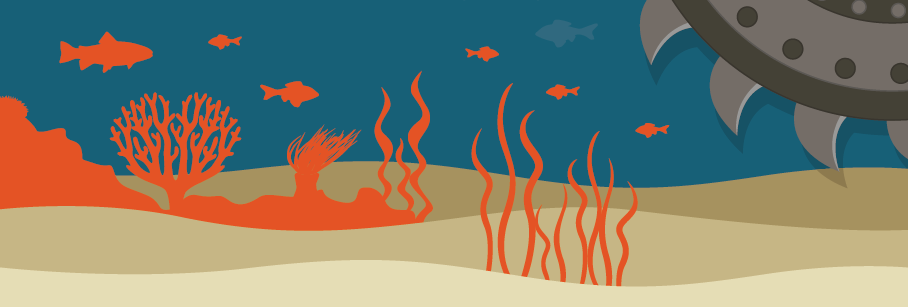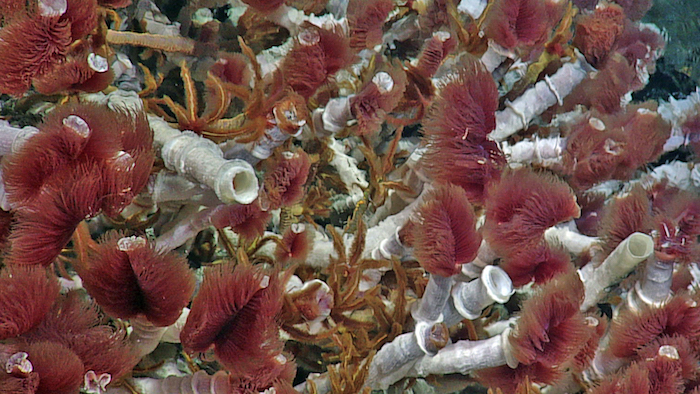
Source: PNG Mine Watch
New research reveals experimental seabed mining could have a devastating impact on life forms that are "literally saving the planet” and preventing a “doomsday climatic event”.
The research lists experimental seabed mining as a major threat to ocean life that resides around hydrothermal vents and has been found to consume enormous quantities of methane that would otherwise enter the atmosphere.
Ironically, Papua New Guinea, which has controversially already approved the mining of hydrothermal vents in its territorial waters, is also home to the world's first climate refugees, people forced off the Carteret islands by rising sea water levels.
Papua New Guinea has also played a major part in international negotiations to reduce the climate impacts of deforestation, work that could be completely 'undermined' by its efforts to promote experimental seabed mining.

Life forms in hydrothermal vents and seeps consume 90 percent of the released methane – a greenhouse gas 25 times more potent than carbon dioxide – and keep it from entering the atmosphere.
Oregon State University | Reporting Climate Science
The hydrothermal vents and methane seeps on the ocean floor that were once thought to be geologic and biological oddities are now emerging as a major force in ocean ecosystems, marine life and global climate.
However, even as researchers learn more about their role in sustaining a healthy Earth, these habitats are being threatened by a wide range of human activities, including deep-sea mining, bottom trawling and energy harvesting, scientists say in a report published in Frontiers in Marine Science.
Researchers from Oregon State University first discovered these strange, isolated worlds on the ocean bottom 40 years ago. These habitats surprised the scientific world with reports of hot oozing gases, sulfide chimneys, bizarre tube worms and giant crabs and mussels – life forms that were later found to eat methane and toxic sulfide.
“It was immediately apparent that these hydrothermal vents were incredibly cool,” said Andrew Thurber, an assistant professor in the OSU College of Earth, Ocean and Atmospheric Sciences, and co-author on the new report.
“Since then we’ve learned that these vents and seeps are much more than just some weird fauna, unique biology and strange little ecosystems. Rather than being an anomaly, they are prevalent around the world, both in the deep ocean and shallower areas. They provide an estimated 13 percent of the energy entering the deep sea, make a wide range of marine life possible, and are major players in global climate.”
Life forms in hydrothermal vents “saving the planet”
As fountains of marine life, the vents pour out gases and minerals, including sulfide, methane, hydrogen and iron – one of the limiting nutrients in the growth of plankton in large areas of the ocean. In an even more important role, the life forms in these vents and seeps consume 90 percent of the released methane and keep it from entering the atmosphere, where as a greenhouse gas it’s 25 times more potent than carbon dioxide.
“We had no idea at first how important this ecological process was to global climate,” Thurber said. “Through methane consumption, these life forms are literally saving the planet. There is more methane on the ocean floor than there are other forms of fossil fuels left in the oceans, and if it were all released it would be a doomsday climatic event.”
In reviewing the status of these marine geological structures and the life that lives around them, a group of researchers from 14 international universities and organizations have outlined what’s been learned in the past four decades and what forces threaten these ecosystems today. The synthesis was supported by the J.M. Kaplan fund.
These vents and seeps, and the marine life that lives there, create rocks and habitat, which in some settings can last tens of thousands of years. They release heat and energy, and form biological hot spots of diversity. They host extensive mussel and clam beds, mounds of shrimp and crab, create some prime fishing habitat and literally fertilize the ocean as zooplankton biomass and abundance increases. While the fluid flows from only a small section of the seafloor, the impact on the ocean is global.
Some of the microorganisms found at these sites are being explored for their potential to help degrade oil spills, or act as a biocatalytic agent for industrial scrubbing of carbon dioxide.
These systems, however, have already been damaged by human exploitation, and others are being targeted, the scientists said. Efforts are beginning to mine them for copper, zinc, lead, gold and silver. Bottom trawling is a special concern, causing physical disturbance that could interfere with seeps, affect habitat and damage other biologic linkages.
Oil, gas or hydrate exploitation may damage seeps. Whaling and logging may interfere with organic matter falling to the ocean floor, which serves as habitat or stepping stones for species reliant on chemosynthetic energy sources. Waste disposal of munitions, sewage and debris may affect seeps.
The range of ecosystem services these vents and seeps provide is just barely beginning to be understood, researchers said in their report. As many of these habitats fall outside of territorial waters, vent and seep conservation will require international collaboration and cooperation if they are going to continue to provide ecosystem benefits.
Contributors to this report included researchers from the Scripps Institution of Oceanography, Florida State University, the National Institute of Water and Atmospheric Research in New Zealand, University of the Azores, Temple University, Universidade de Aveiro, the U.S. Geological Survey, University of the West Indies, Dalhousie University, University of Victoria, Duke University, Ghent University and the University of Hawaii at Manoa.
Abstract
Although initially viewed as oases within a barren deep ocean, hydrothermal vents and methane seep chemosynthetic communities are now recognized to interact with surrounding ecosystems on the sea floor and in the water column, and to affect global geochemical cycles. The importance of understanding these interactions is growing as the potential rises for disturbance of the systems from oil and gas extraction, seabed mining and bottom trawling. Here we synthesize current knowledge of the nature, extent and time and space scales of vent and seep interactions with background systems. We document an expanded footprint beyond the site of local venting or seepage with respect to elemental cycling and energy flux, habitat use, trophic interactions, and connectivity. Heat and energy are released, global biogeochemical and elemental cycles are modified, and particulates are transported widely in plumes. Hard and biotic substrates produced at vents and seeps are used by “benthic background” fauna for attachment substrata, shelter, and access to food via grazing or through position in the current, while particulates and fluid fluxes modify planktonic microbial communities. Chemosynthetic production provides nutrition to a host of benthic and planktonic heterotrophic background species through multiple horizontal and vertical transfer pathways assisted by flow, gamete release, animal movements, and succession, but these pathways remain poorly known. Shared species, genera and families indicate that ecological and evolutionary connectivity exists among vents, seeps, organic falls and background communities in the deep sea; the genetic linkages with inactive vents and seeps and background assemblages however, are practically unstudied. The waning of venting or seepage activity generates major transitions in space and time that create links to surrounding ecosystems, often with identifiable ecotones or successional stages. The nature of all these interactions is dependent on water depth, as well as regional oceanography and biodiversity. Many ecosystem services are associated with the interactions and transitions between chemosynthetic and background ecosystems, for example carbon cycling and sequestration, fisheries production, and a host of non-market and cultural services. The quantification of the sphere of influence of vents and seeps could be beneficial to better management of deep-sea environments in the face of growing industrialization.
- ACTNOW's blog
- Log in to post comments
